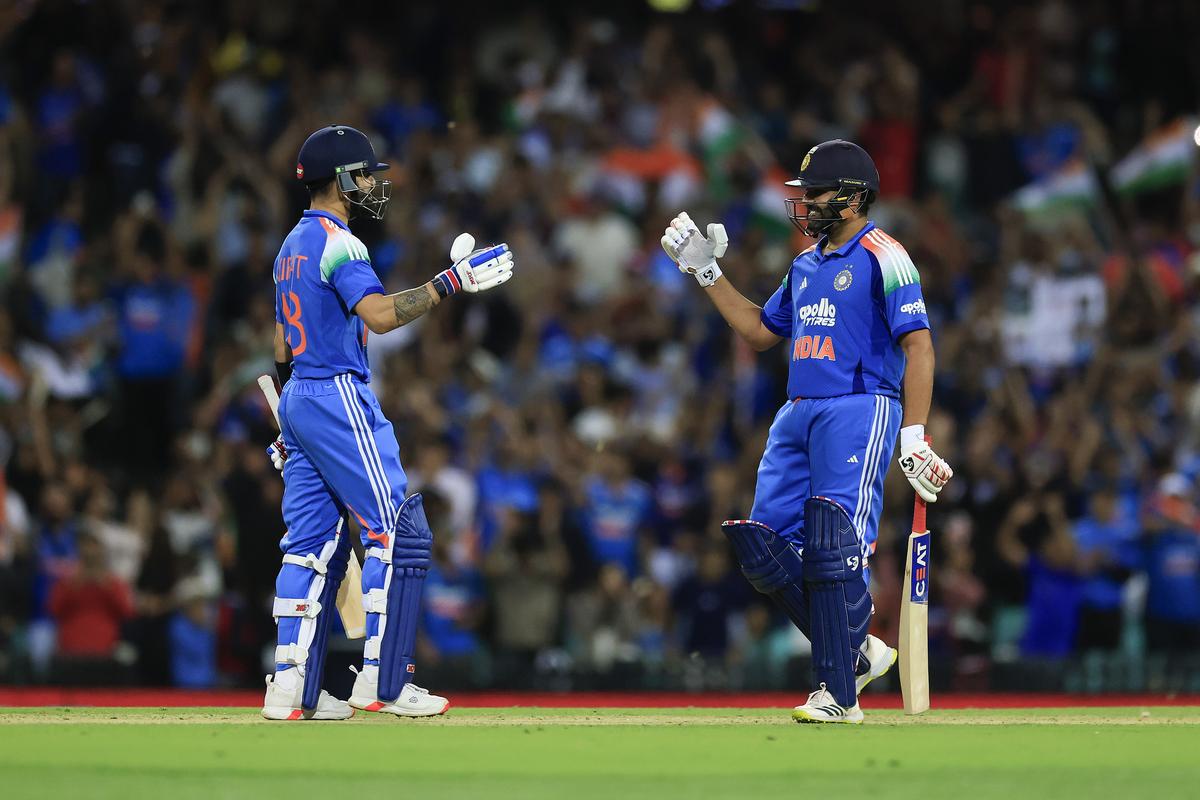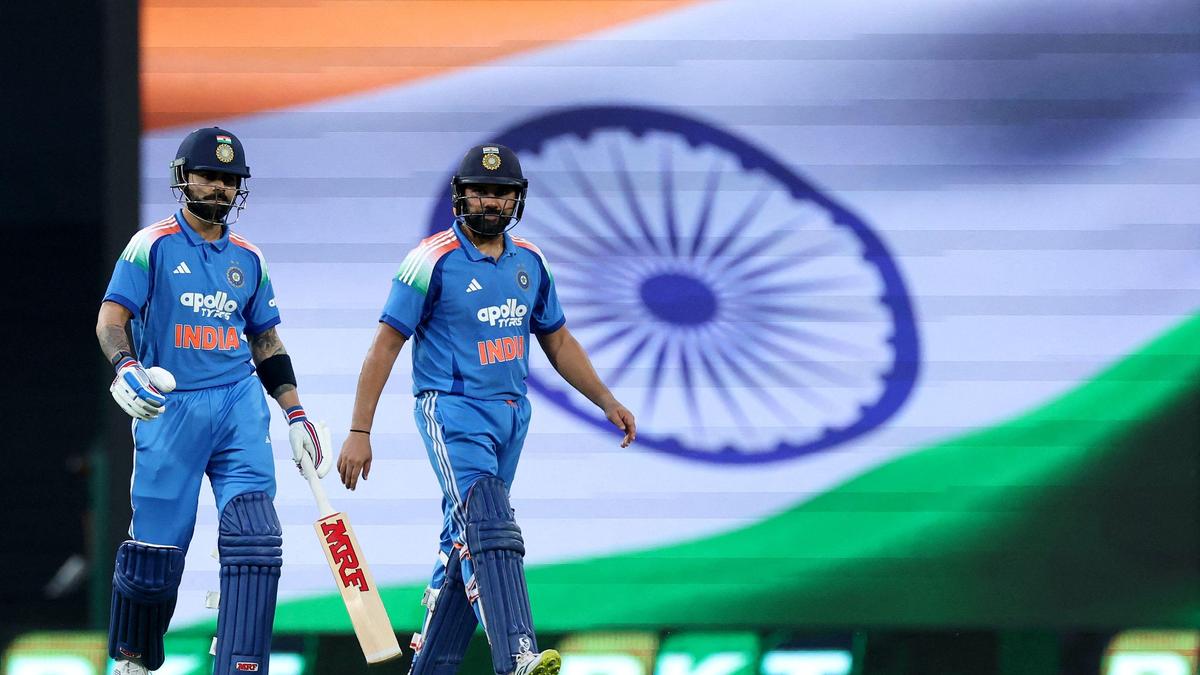Rohit Sharma prone on the Queen’s Park Oval turf on 29 June 2024, repeatedly pummelling the ground with his right hand, is one of Indian cricket’s iconic images, on par with Kapil Dev lifting the 1983 World Cup trophy at the Lord’s balcony and Mahendra Singh Dhoni’s winning six off Nuwan Kulasekara in the 2011 World Cup final at the Wankhede.
The unusually exuberant public show of emotion from the Mumbaikar was understandable. It entailed ecstasy and delight, of course, but it was also fuelled by relief and redemption; it was the venting of frustrations coiled tightly inside for seven-and-a-half months. It was only minor compensation for stumbling at the final hurdle in the 50-over World Cup final in Ahmedabad the previous November, but compensation nevertheless.
Unlike Virat Kohli, his India teammate for more than a decade and a half, Rohit isn’t renowned for attracting the spotlight for more than only his cricket. He does wear his heart on his sleeve and is given to the odd outburst, but it lasts no more than a few seconds and is immediately followed by a smile that takes away any perceived edge. Except when he is taking bowling attacks apart, Rohit is a mild-mannered, affable individual who keeps his emotions well in check.
It was, therefore, no surprise that there were no outlandish celebrations, no gravity-defying leap in the air, no first-clenching and bat-pointing, in the immediacy of his 33rd One-Day International century, at his cherished Sydney Cricket Ground on Saturday. Had he screamed his lungs out and waved his bat furiously in the direction of the dressing room or anywhere else, it would have been perfectly justified. Had he let off a few expletives, ala Kohli, it would have been laughed off as uncharacteristic but merited. But that really wouldn’t have been Rohit, would it?
Change of guard
After three-and-a-half years masterminding India’s fortunes across formats, this snappy three-match 50-over faceoff against Australia was Rohit’s first outing in his new avatar, as just one of the players – inasmuch as he can be just one of the players. Retired from T20Is after the spectacular triumph in the World Cup in Bridgetown which catalysed his assault on the Queen’s Park Oval infield and from Tests after a disastrous last season which yielded just one half-century and a whopping six losses in eight Tests as batter and captain, Rohit was stripped of the ODI captaincy earlier this month.
This, despite the fact that he had led the country to the Champions Trophy crown in March, in India’s last 50-over engagement. Despite the fact that Shubman Gill, already the Test captain, had been entrusted with the ODI vice-captaincy too. Despite the fact that matches – Tests, ODIs, T20Is — were coming thick and fast, that Gill seemed to have plenty on his plate. Undoubtedly with inputs from head coach Gautam Gambhir, Ajit Agarkar’s selection panel decided that even though the next 50-over World Cup was two years away and even though Gill appeared overburdened on all fronts, the time was ripe for him to be handed over the ODI leadership role too.
Gill hasn’t had a great run in white-ball internationals in the last six and a half weeks. He had a highest of 47 and just one other effort of more than 20 in seven T20I knocks in the Asia Cup in the UAE last month. Over the last week, in the three ODIs in Australia, he has managed 10, 9 and 24. That proves little, one might say, given that in his first series as Test captain, he smashed four centuries in England on his way to 754 runs, and that he made a half-century and a hundred in the two home Tests against West Indies earlier this month. But that is a discussion for another day.

| Photo Credit:
Getty Images
Back to Rohit. His last competitive outing was on June 1, during Mumbai Indians’ loss to Punjab Kings in Qualifier 2 of IPL 2025. He had gone four-and-a-half months without a game, his longest gap away from the sport in a while when he has been fit and available. Rohit spent the first half of that hiatus partaking of top-class action in the English summer, including Wimbledon and the Oval classic between Gill’s boys and Ollie Pope’s England in the series-deciding Test. When he returned to India, his competitive fire stoked, he got down to work with old friend Abhishek Nayar, briefly India’s batting coach who fell out of favour after the 1-3 hammering in the five-Test series Australia the previous winter.
Nayar and Rohit go back a long way, their relationship based on trust and honesty. Nayar was by Rohit’s side when he channelled the heartbreak of being left out of the 2011 World Cup side positively and came surging back to establish himself as one of the greatest white-ball batters of all time. Life came full circle a couple of months ago when the two Mumbaikars reunited to turn the clock back and facilitate Rohit becoming the best version of himself.
Fourteen years previously, Rohit was a motivated 24-year-old; would a wizened, gnarled 38-year-old be able to summon the same intensity of then? How badly did he want it, as they say?
Quite badly, it is evident. The emphasis wasn’t just on getting his batting in order, it was also to become fitter, leaner, swifter, more athletic-looking, which seems to impress people more than being just cricket-fit. Rohit shed kilos (10,000 grams, Nayar helpfully informed us) and honed his batting. He didn’t leave any stone unturned as he emplaned for Perth where, would you believe it, he had never previously played an ODI.
Quick exit
Rohit’s first game back as one of the boys was terminated at eight by Josh Hazlewood, the metronomic pacer who produced an excellent delivery that moved away a smidgeon, if that, squared up the right-hander and elicited an edge to second slip. The Optus can do it, with its extra bounce; the ball hit Rohit high up on the bat, nearer the splice. A spiteful ball that would have produced a wicket eight times out of ten.
A better batting surface greeted the teams in Adelaide, but Hazlewood was once again at it. At one point, he bowled 17 dot balls to Rohit, beating him on the outside edge, on the inside-edge, rapping him on his pads, his thigh, his breadbasket. Rohit didn’t flinch, he didn’t lapse into bravado. He bided his time, trusted his game plan and when Hazlewood went off the attack, switched gears to make a superb 73. Not enough for victory, but enough to suggest that the Hitman was nearly there.
Saturday and Sydney confirmed Australia’s worst fears and sent millions of Indian cricket fans into paroxysms of delight. Rohit purred along beautifully while Kohli, coming off successive ODI ducks for the first time in his celebrated career, rode early luck before slipping into an active supporting role. There were trademark drives over the top on the off-side, uncompromising sweeps and a dismissive pull off the front foot against Hazlewood that flew over wide mid-on, the ultimate statement in an innings full of statements even if that wasn’t Rohit’s intention.
Those who have watched him on television over the last week will agree that Rohit hasn’t been as ready with a smile as in the past, that there is something slightly different about him. He is not aloof, no way, because that’s not how he is wired. Gill sought out his counsel off the field and on it, and Rohit was always by his side with a suggestion, a slice of pithy advice (such as going to slip against Mitch Owen off a reluctant Harshit Rana and pouching a catch there not long after) and a shoulder around the arm when needed. But he is a lot more serious, a side of Rohit we haven’t witnessed in a long, long time, maybe because he feels the need to prove a point or three – to himself, more than to anyone else.
Saturday was Rohit’s 50th international hundred. Only two other Indians, Sachin Tendulkar and Kohli, figure in the last of 10 batters worldwide who have reached that milestone. It’s a staggering accomplishment, a tribute to Rohit’s legacy which, one suspects, will be eulogised and extolled commensurately once he hangs up his boots, whenever that is. He must have derived a certain satisfaction from the fact that when he brought up three-figures, his batting partner was Kohli, the darling of the masses, one half of what the creatively inclined have labelled Ro-Ko.
Rohit and Kohli have seen numerous ups and downs, been teammates and rivals (in the IPL), gone through good times and not-so-good ones, and contributed immensely when the other has been the skipper. Rohit, as everyone will readily recall, smashed five centuries in the 2019 World Cup when Kohli was in charge in England which, he said, meant little because India crashed out in the semis. Kohli returned the compliment with three tons in the 2023 edition, was the Player of the Final at the T20 World Cup last year and marshalled successful run-chases against Pakistan and Australia (semifinal) of the Champions Trophy this year with scores of 100 not out and 84 respectively.
To see the two ‘old dogs’, as Ravi Shastri called them in a post-match chat, join hands one last time in Australia to overwhelm the old foe was exhilarating. It was as if they had made time stand still. The fans, nearly 35,000 of them at the ground bathed in blue – Kerry O’Keefe, the former Aussie leg-spinner, said he had never seen such one-sided support for the visiting team in his 60-year involvement with the game – couldn’t have enough of it. Rohit and Kohli sparked an electric atmosphere with their 19th hundred-plus stand in ODIs; it was their first such alliance since January 2020.
Rohit’s batting approach, conservative to start with, has been attributed to his changed status within the team. Conveniently forgotten was the challenge the pitches threw up. Next month in India? The PowerPlay destroyer will be back, make no mistake.

